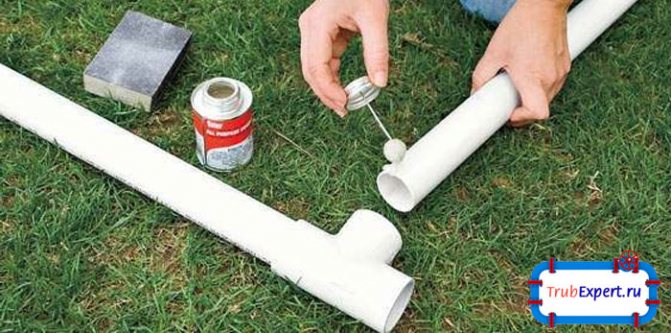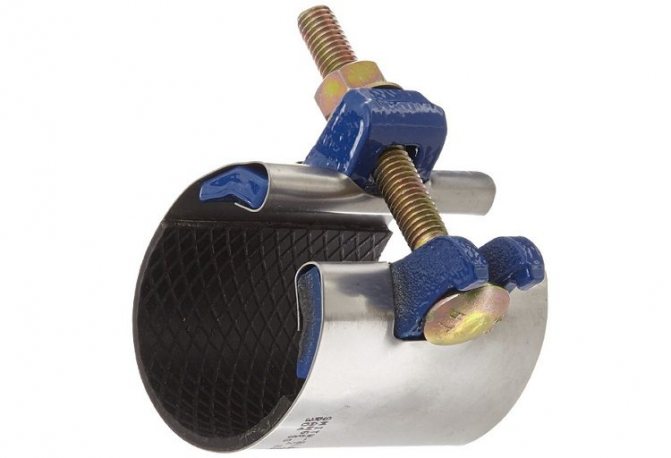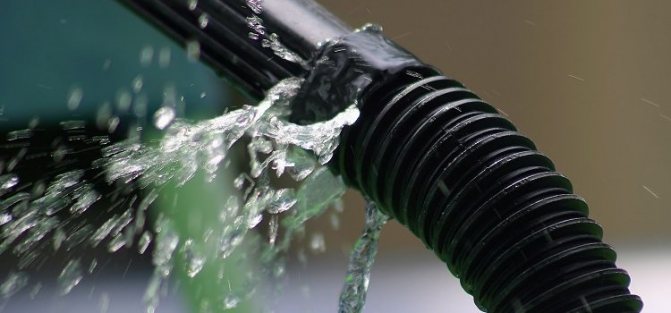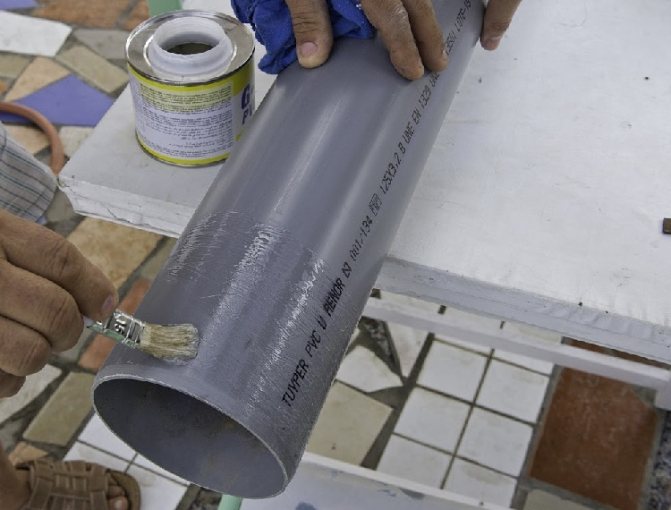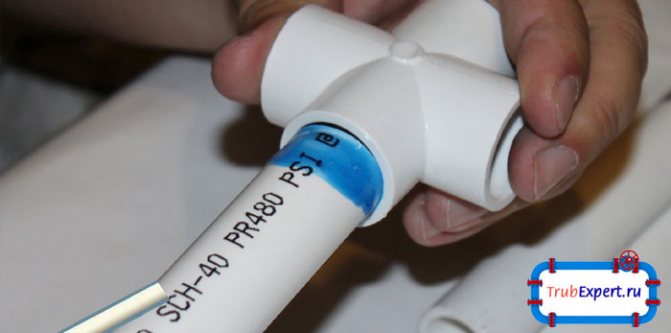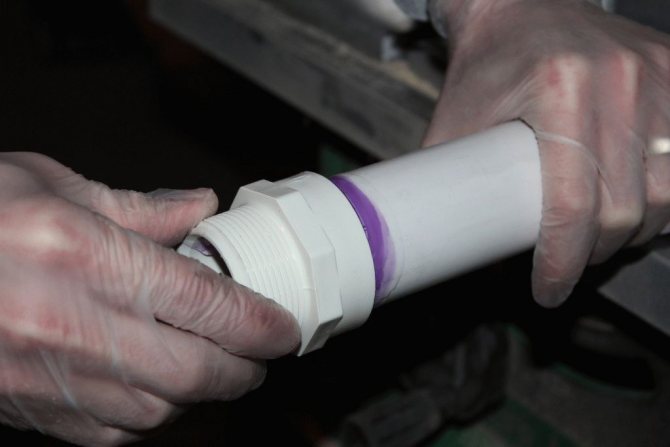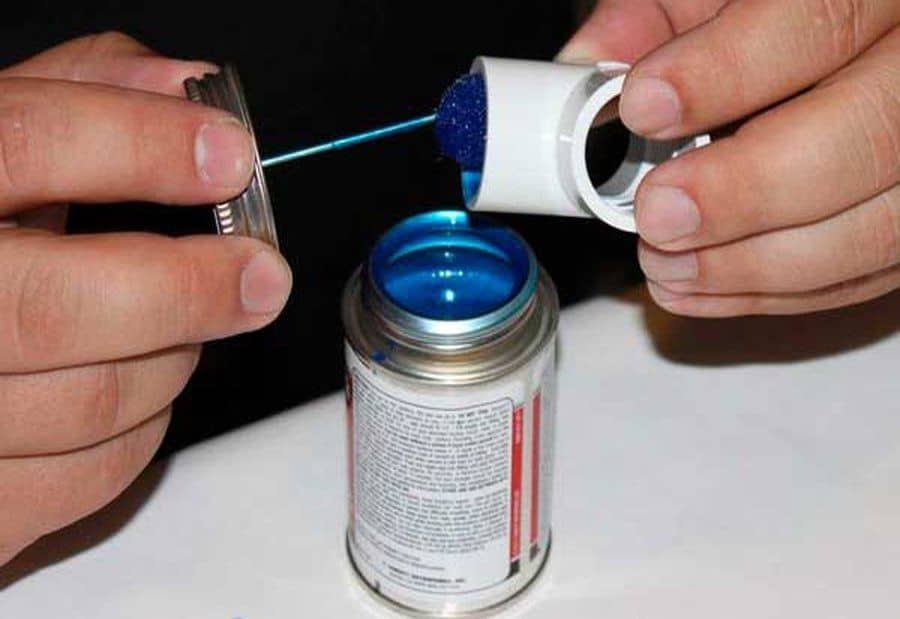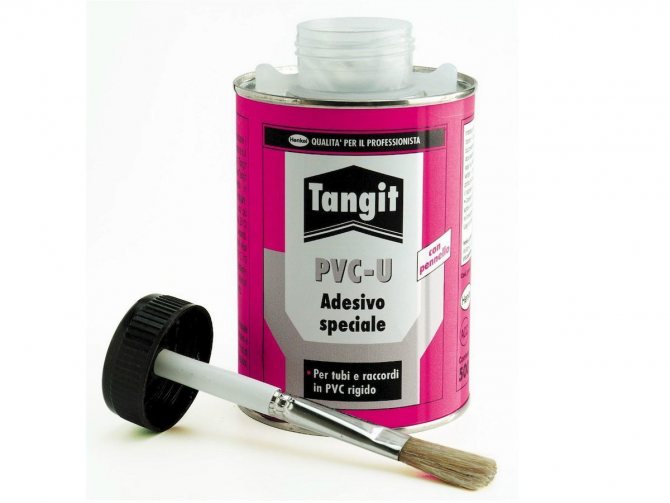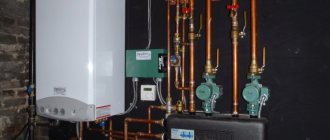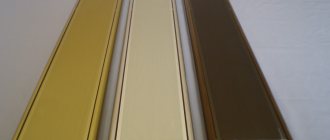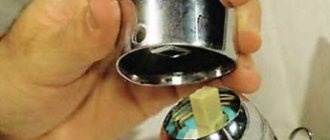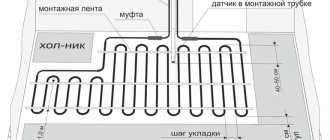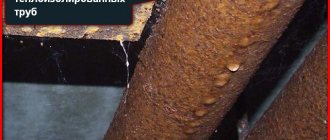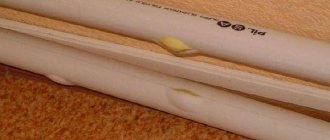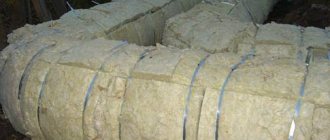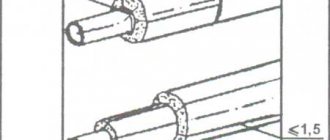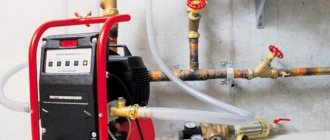The knowledge of how to glue a sewer plastic pipe when the necessary equipment is not at hand will be useful to every home craftsman. A frequently occurring leak must be eliminated urgently when it is not possible to replace the damaged element. You can completely assemble the plastic piping system using special adhesives.
Sealing PVC pipes
The composition and principle of action of adhesive materials
Plastic products are glued using specialized chemical compounds that dissolve the outer surface of the material. The active ingredient in most variants is methyl ethyl ketone, cyclohexane or tetrahydrofuran. Adhesive for sewer pipes made of PVC or polypropylene is made on the basis of the same substance as the parts of the pipeline themselves. In addition, various additives are mixed into the adhesive materials, which allow to influence the viscosity of the mixture and its setting time, as well as improve adhesion.
In the process of glue hardening, plastic pipes are rigidly connected due to the interweaving of molecular polymer chains on the outer surfaces of the parts to be joined. The solvent is then evaporated and a compound is obtained that has the same characteristics as a new one-piece product.
Features of the assembly of plastic pipes
When choosing how to glue a plastic sewer pipe, you need to study the issue more carefully. In total, there are three ways to connect plastic elements:
- bell-shaped;
- welding;
- adhesive connection.
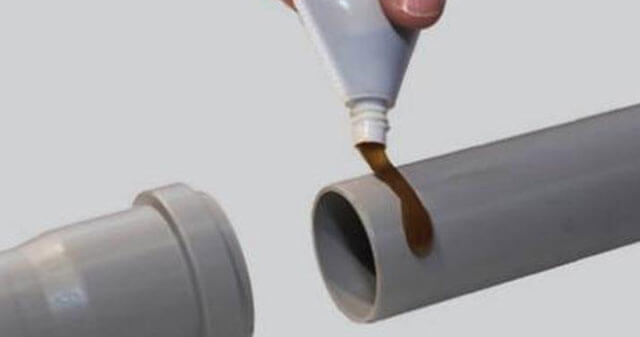
Most plastic pipelines are connected to a bell with a rubber seal. This is the easiest and fastest way to build systems. If necessary, such a line is easy to disassemble, replace the damaged element, insert additional parts. However, this connection method has one drawback - only frictional force holds the connection. Since plastic has a high coefficient of thermal expansion, a significant difference in size will result on long lines. One of the sockets where the rubber seal is dry or cracked will become a risk factor. At the first opportunity, it will disperse, which means the termination of the entire system.
Welding forms a tight and monolithic connection. It will be impossible to tear off one part from another, which makes it possible to build lines with high strength. They are not afraid of external loads. However, this method complicates the repair. In addition, welding is done using special equipment and tools, it requires experience and skills. Therefore, in this way, only critical lines are connected, they are used for industrial sewage. For this, a special glue is used for PVC, propylene or polyethylene sewer pipes. Most often, vinyl elements of the system are used, so most formulations are designed to work with them.
Advantages and disadvantages of a glue line
Advantages of adhesive bonding:
- reliability, tightness of the connection. The contact between the surfaces and the glue is at the molecular level, therefore extreme conditions (high temperature or pressure) are needed to break the seam;
- simplicity, accessibility of the method. The technology is clear to everyone, the quality depends only on the accuracy and thoroughness of the work;
- installation speed is inferior to assembly into a socket, but there is no need to wait for each joint to harden.You can continue to work sequentially moving along the line until the finished seams are seized;
- no need to buy or rent equipment;
- you do not have to use energy resources, you can work in the field;
- the technique is universal, suitable for connecting pipes or fittings of any size.
This method also has disadvantages:
- the connection is made forever, without the ability to disassemble the seam. This makes it difficult to repair or replace defective parts;
- for the glue to harden, certain conditions are required - temperature, humidity, etc.;
- when choosing glue for plastic sewer pipes, one must take into account the characteristics of the material. Some compounds work well with PVC, but cannot bond polyethylene. It is necessary to carefully study the information on the packaging of the product.
It must be remembered that pipes of a special design are used for the adhesive connection. They are similar to bell-shaped, but do not have a rubber seal, and the gap between the inner section and the cuff is much smaller.
How to choose an adhesive?
When choosing how to glue the sewer pipe, you need to pay attention to the following factors:
- bonding material;
- setting duration;
- technology of use;
- temperature conditions;
- time and storage conditions after opening the package.
All the necessary information is described in detail in the instructions, which should be carefully studied.
There are 2 main groups of adhesive materials for gluing plastic pipes:
- One-component formulations. Such products are sold ready-made and do not require preliminary mixing of the components. Adhesives are packaged in glass, plastic or metal containers and are used to join different types of plastic. They consist of dissolving, softening and joint-forming chemically active substances. But they do not have additives or additives that can change the duration of the course of a chemical reaction and enhance the strength of the abutting place. A typical example of such materials is sealant for PVC and polypropylene (Moment).
- Two-component formulations. They are produced in 2 separate components, which are in different packages. They are mixed immediately before use. Chemically more complex compounds, since they include elements that improve adhesion and reduce the evaporation time of solvent components. The addition of additives promotes the acceleration of the formation of stable polymer chains, due to which bonds of the atomic level are obtained stronger. Higher quality of the joint is provided.
A convenient and effective way to quickly glue all types of pipelines is to use a special sealing tape.
Repair of cracks by cold welding
Specialty stores now offer special cold welding for sewer pipes. It is made specifically for the repair of plastic products used in the organization of water supply systems, cooling systems, heating communications.
Damage of almost any degree of difficulty can be repaired by cold welding. In this case, thermal action is not required, since a chemical reaction is used to bring the constituent components into working condition.
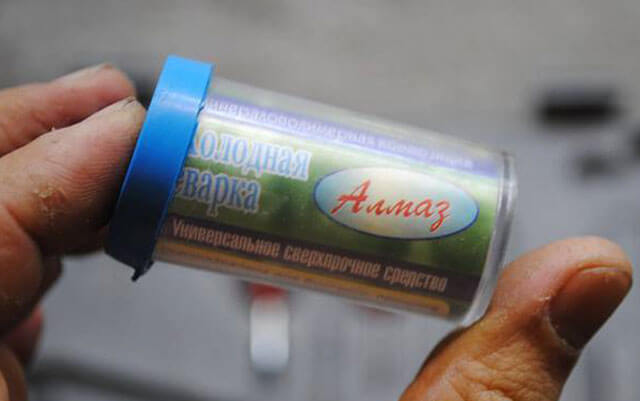

The work itself to repair a damaged plastic pipe has the following sequence:
- It all starts with surface preparation, for which the entire problem area is treated with an emery cloth. This is followed by degreasing the base with alcohol-containing liquids. If you neglect this procedure, the applied patch will serve several times less.
- It is necessary to calculate exactly how much material is required for a high-quality embedding. For this, a simple visual inspection is usually enough: the main thing here is that the repair mass can cover the entire problem area.
- The substance must be taken in hands, on which protective rubber gloves are pre-put on, and begin to knead. This procedure is continued until the material is colored in a specific brown shade. Another sign of the readiness of the material is that the mass has reached the state of plasticine.
- With the finished plastic material, you need to close up the damage well by pressing it with a tourniquet. Then there is a pause in work, for about an hour: during this time, the repair mass solidifies. It must be made so strong and dense that any drilling, cutting and other impacts on its surface are completely safe.
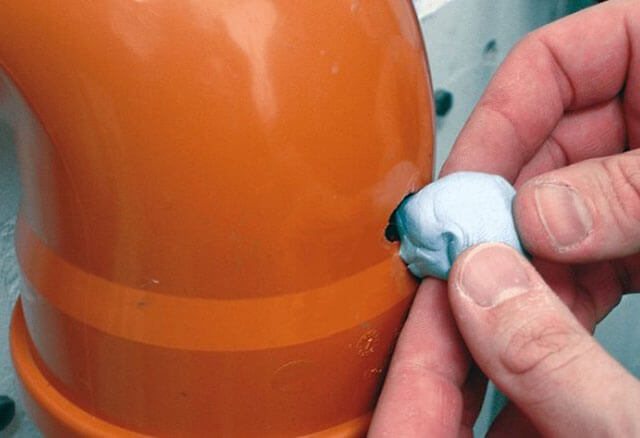

It is important to take into account the presence of components harmful to the human body in the composition of cold welding. For safety reasons, it is recommended that you obtain protective gloves and goggles in advance. To speed up the process of solidification of the plastic mass, some experts recommend exposing it to warm air using a construction or ordinary hair dryer.
Cold welding for sewer pipes is suitable for repairing damaged plumbing. For example, if a piece of material breaks off from a sink or toilet bowl, cold welding will help to glue it back with good quality. When buying this universal remedy, you should check its expiration date, compositional features and the availability of a quality certificate.
Polymer products are replacing metal and ceramic pipes. They are becoming more and more popular due to their obvious advantages - durability, lightness, resistance to corrosion and aggressive substances. With careful handling, the plastic pipeline can serve for at least half a century.
The main thing is to ensure a high-quality, airtight docking of the elements. To assemble the parts, use a special glue for PVC pipes. The so-called "cold welding" allows you to build a water supply system with minimal labor costs. However, the use of glue has a number of nuances that must be studied before starting work.
How to prepare and glue plastic piping elements?
Since the pipe adhesive contains toxic volatile components, all work should be carried out in a well-ventilated area. The temperature should be within + 5 ... + 35 ° С. It is recommended to protect hands with rubber gloves to avoid causing an allergic reaction or irritation.
The sequence of actions is as follows:
- Cut pipe sections of the required length using special scissors (pipe cutter) or a fine-toothed saw. The edges of the cut are cleaned with a file and sandpaper to remove chips and burrs.
- Then the bonded area of the surface must be well cleaned of dirt and dried thoroughly.
- The preliminary assembly of the pipeline structure and the final adjustment of all elements are carried out.
- Before gluing the damage or gluing all the parts together, the gluing points must be degreased with a special solution or an alcohol-containing liquid.
- The adhesive is thoroughly mixed. When applying the repair method with two-component glue, measure the required amount of material and knead it with your hands until it is ready (plasticine consistency).
- Using a brush or applicator, the glue is evenly distributed over the prepared surface. The parts are joined and fixed in a stationary state for several minutes (the exact time is indicated in the instructions). Reapplication is sometimes required. A thick mastic is applied to the repaired area and strongly pressed with a tourniquet.
- Excess glue protruding along the edges of the joint is removed with a paper napkin or rag.
- The connected parts are left alone until the adhesive is completely dry.
The general tightness of the joints and the reliability of the entire structure are checked no earlier than after 24 hours.When sealing the leak, the repair mass hardens in an hour.
Using a sealant or adhesive
Damaged plastic pipe can be sealed. If blind cracks or other blind defects are found in the sewer pipe, they can be repaired with silicone sealant. For this, it is necessary, if possible, to expand the crack in order to increase the contact surface. Then this area is degreased and dried. After that, a sealant is applied to the crack, which should dry well.
A through hole in a sewer or water pipe can also be sealed with a quality two-component epoxy adhesive. The work is carried out in the following order:
- the pipe surface in the problem area is thoroughly cleaned, degreased and dried;
- a bandage is being prepared, for which a piece of fiberglass of a suitable size can be used;
- the restored section of the pipe is tightly wrapped with a bandage of at least 5 layers. When winding, the damage must be completely covered;
- the bandage is thoroughly coated with epoxy glue.
Causes of defects when gluing PVC pipes
Sometimes, some time after sealing a crack in a PVC pipe or gluing the entire structure, fluid leakage is observed at the joints. Most often, the reasons are the following technological violations that were made during the work:
- Poor surface preparation on old pipe and severe irregularities. In case of poor processing of the cut edges, when roughness remains on the material, the adhesive dissolves and softens the material unevenly.
- Contamination remained on the treated areas. Unfatted surfaces also cannot be well impregnated with glue.
- Unevenness in the application of the adhesive leads to non-gluing in some places of the joint.
- The seam is not completely glued if a thin surface film has formed on the adhesive layer due to its overdrying. All work must be done quickly.
- A soft and loose glue layer instead of a good strong joint is formed at low ambient temperatures during work. In this case, the solvent does not completely evaporate and the composition does not harden.
- A porous adhesive layer may remain if the components are poorly mixed prior to application. Remaining air bubbles weaken the seam greatly.
- Insufficient compression force or lack of holding time, as a result of which there is a distortion and displacement of the parts to be glued during the curing of the composition.
- Incorrectly selected brand of glue.
In order not to have to take additional measures to eliminate the leakage due to poor-quality gluing, it is necessary to correctly select the adhesive composition and strictly observe the technology of the work.
What do you need to work?
First of all, these are the pipes and fittings themselves. You can read in detail about the diameter and dimensions of the sewer pipe in another article, we will only recall the obvious fact that pipes should be of the same brand. Otherwise, difficulties may arise even when connecting pipes of the same size but from different manufacturers.
In addition, you will need: • A hacksaw or other fine-toothed cutting tool. •File. • Sandpaper. •Solvent. •Glue. •Brush.
As for the glue, there are both specialized brands intended exclusively for PVC pipes and universal ones used for joining various materials that include PVC or its derivatives. The best option is specialized adhesives, many of which guarantee a reliable joint for 10 years or more.
Adhesive for PVC pipes: the choice of composition and rules of use
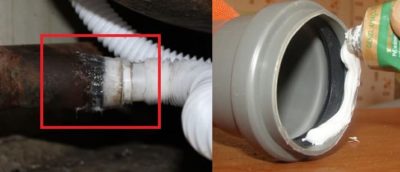

Propylene and PVC pipes are widely used in the installation of heating systems, water supply, sewerage systems. Connections of such pipes can be done in several ways, one of the most popular is gluing, or "cold welding".
In order for the reliability of the seam to be high, it is necessary to choose the right adhesive for PVC pipes. The strength of such a joint will be no worse than that of a conventional welded joint.
Plastic pipes for gluing
Unlike metal pipes, polypropylene products can be assembled independently, even without special skills. Experts prefer not to use ordinary plastic for hot water pipes or heating pipes, but use it for sewer communications. But some types of products (in alloys with metal) are quite suitable for both cold and hot water. The advantages of polypropylene pipes are undeniable:
- resistance to changing natural conditions (pressure drop, temperature drop, humidity increase);
- lack of corrosion;
- long service life (over 50 years);
- ease of installation, gluing, repair;
- moderate cost;
- health safety.
Such a pipeline also has disadvantages. The elasticity of the material when heated may decrease, the coefficient of expansion is high. Under the influence of the sun, some types of plastics age faster, which must be taken into account during installation.
The equipment of a house with a water supply and a sewage system using PVC pipes can be performed with products of different types. Depending on the constituent components and manufacturing technology, the following types of plastic pipes are produced:
- Made of polyvinyl chloride (PVC). The most rigid, gluing them is quite simple. They do not burn, do not react to UV radiation, light. Unfortunately, chlorine is used in the production process, so PVC pipes are not environmentally friendly.
- Polyethylene. Very durable, elastic, easily tolerate even freezing water, do not burst. Inside they are smooth, water does not leave plaque in them, deposits of impurities. Among the minuses, it is necessary to point out that they are not suitable for hot water - they begin to melt. Connected with clamp fittings. A separate type is XLPE pipes, which are used for the underfloor heating system.
- Polybutylene. Suitable for water with temperatures up to +90 degrees, but they are not mounted by gluing. Used in the installation of heating systems.
- Polypropylene. They are used for hot and cold water, for sewerage, heating, very easy to install. They are connected by soldering, they can also be welded.
- Made of metal-plastic. Includes aluminum, is an aluminum alloy with plastic. Due to the three-layer base, they are suitable for water supply, heating, withstand temperatures up to +110 degrees.
Causes and ways to eliminate pipe leaks
There are many reasons that cause an emergency:
- installation work was carried out with obvious violations;
- the presence of defects in the manufacture of fittings and pipes;
- improper operation of the sewage system.
What actions should be taken first of all:
- Turn off the water supply valve in the problem pipeline.
- The segment that needs to be replaced is wiped dry and the boundaries are marked with a marker with a small margin of 2 to 4 cm on each side of the leak.
- Cut off the selected part of the segment with scissors and prepare a new pipe.
- Cut a thread at the point of pipe connection, taking into account that the thread corresponds to half the length of the coupling.
- The pipes are connected using fittings and couplings.
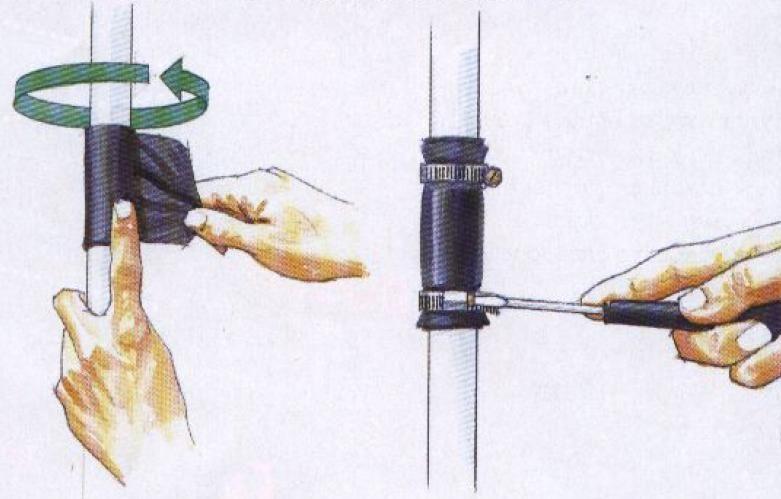

Sealing with a sealing tape is a fairly new and very convenient method, which was created specifically for tightly sealing pipe joints.
What to do if a long crack appears? How to close the sewer pipe in such an emergency? The cause of the crack must be identified immediately. Usually, in such places, moisture appears and condensation forms on the pipe.Next, follow these steps:
- Spread the crack as wide as possible so that the sealant can penetrate deeply without difficulty.
- Then degrease the surface of the crack and dry well.
- A layer of sealant is applied to the damaged area and allowed to dry for a while.
From experience it follows that in order to avoid the occurrence of cracks in the future, it is necessary to insulate the pipes as best as possible. And if a through crack appears, then how can you cover up the sewer pipe? Such serious damage is repaired with a two-component adhesive, which is prepared according to the instructions. Then it is applied to a prematurely dried and degreased surface.
We use sealing tape
One of the modern ways to eliminate small pipe leaks in a bathroom or toilet is the use of sealing tape. This material is a special impregnated adhesive fabric. As a rule, sealing tape is used at joints and joints, but it is quite suitable for straight sections.
The work progress will look like this:
- The pipe section to be repaired is cleaned of contaminants and dried.
- Stretch a small piece of tape and start winding it around the pipe. In this case, the material must be constantly kept in tension in order to prevent the appearance of folds.
- When winding, the next section of the tape should be laid on half of the previous one. As a result, your pipe will be “packed” in two layers of sealing material.
Note! This method has one drawback. The sealing tape does not tolerate sunlight well. Therefore, the repaired area must be covered with a protective layer.
What to do first of all if a leak occurs
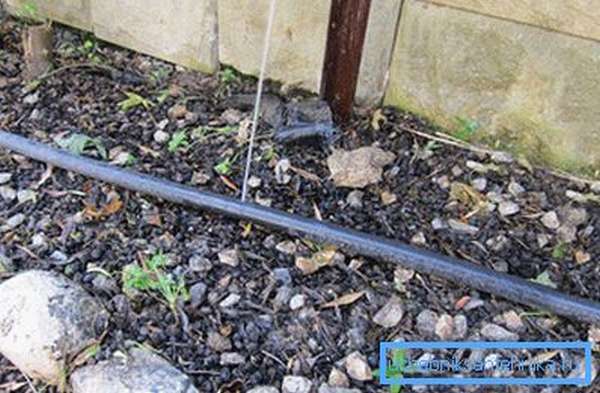

If there is a leak in high-pressure pipes, heating system or other communication in an apartment or house, then first of all, you need to close the shut-off valves. This truth is familiar to everyone. But what to do next?
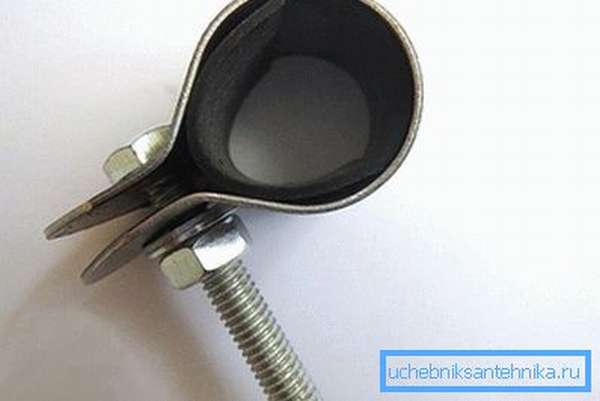

The emerging leak can be "plugged" with clamps. Such structures are in the required area and are tightened with bolts.
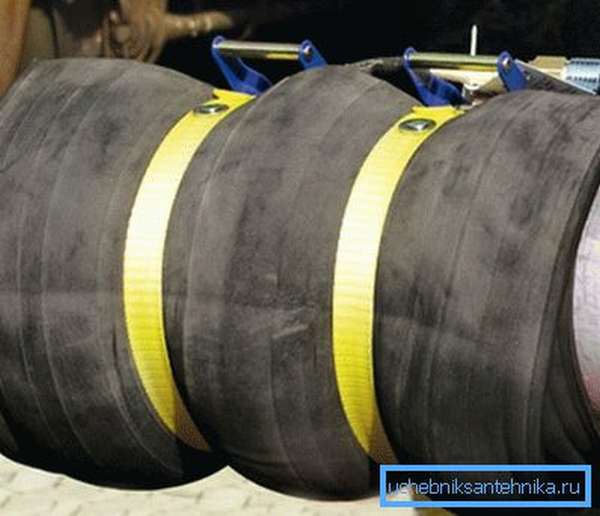

It is possible to use a dilapidated method - to use rubber. In this way, I quite often repair a heating or water supply pipe. The problem area is wrapped with a piece of rubber (for example, from car tires) and clamped with a clamp or pulled over with a narrow wire or strong cord.
Advice! It is possible to use a simple paint. The place where a crack or leak appears is wrapped with a cloth and painted over with oil paint.
But all of the above methods can be considered a temporary solution. If such patches are left for a long time, the leak will appear again. Just on this basis, many masters advise replacing the problem area, especially since it is quite easy to do this using plastic pipes.

